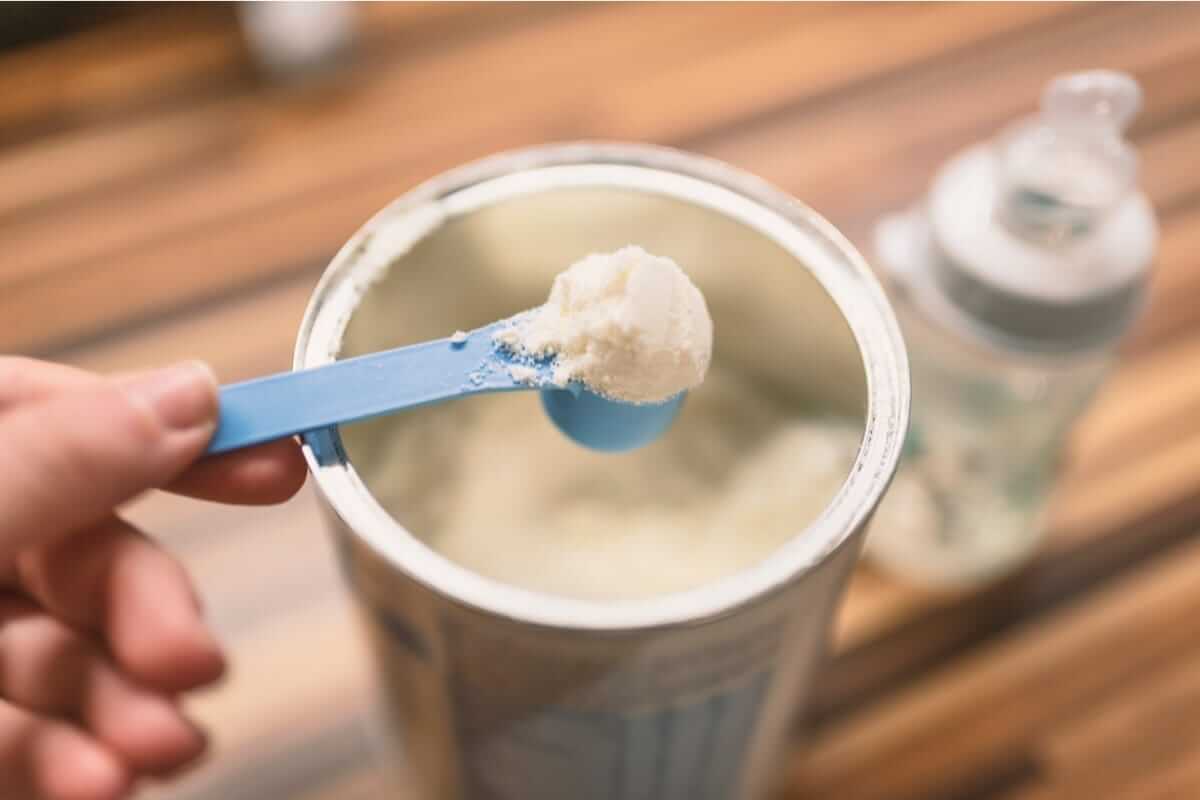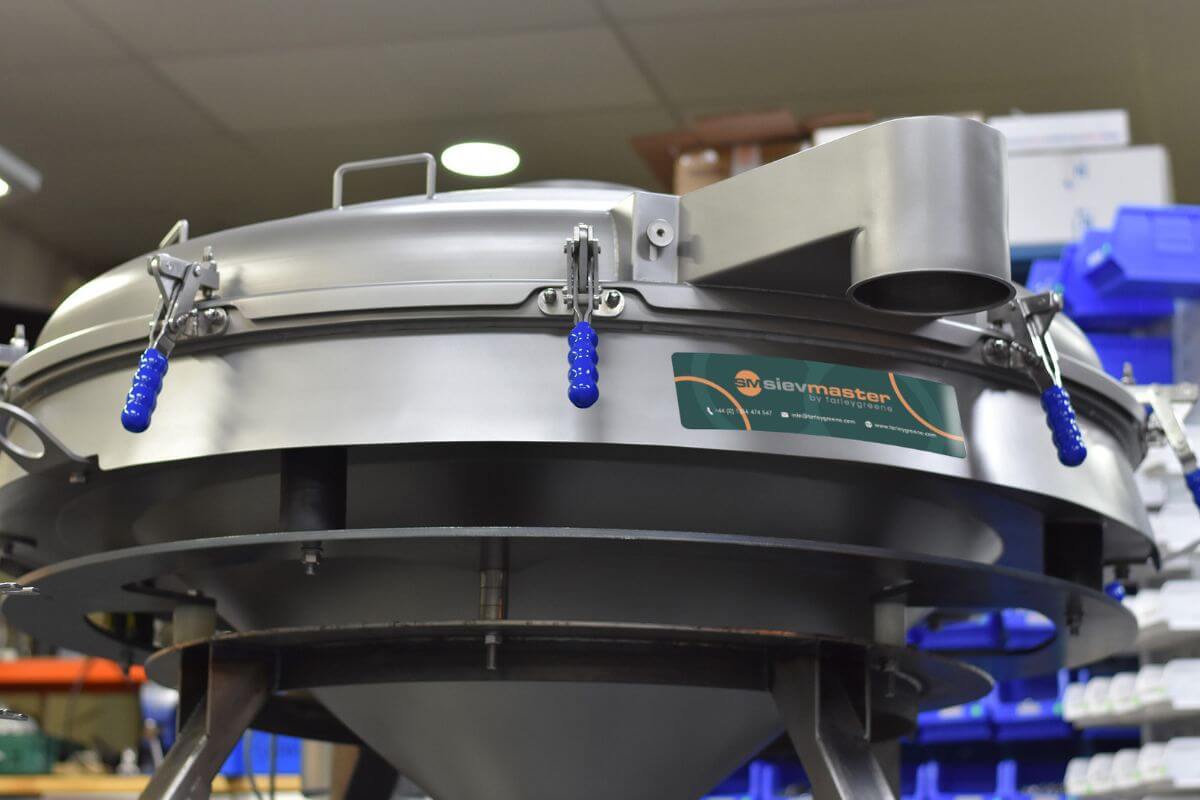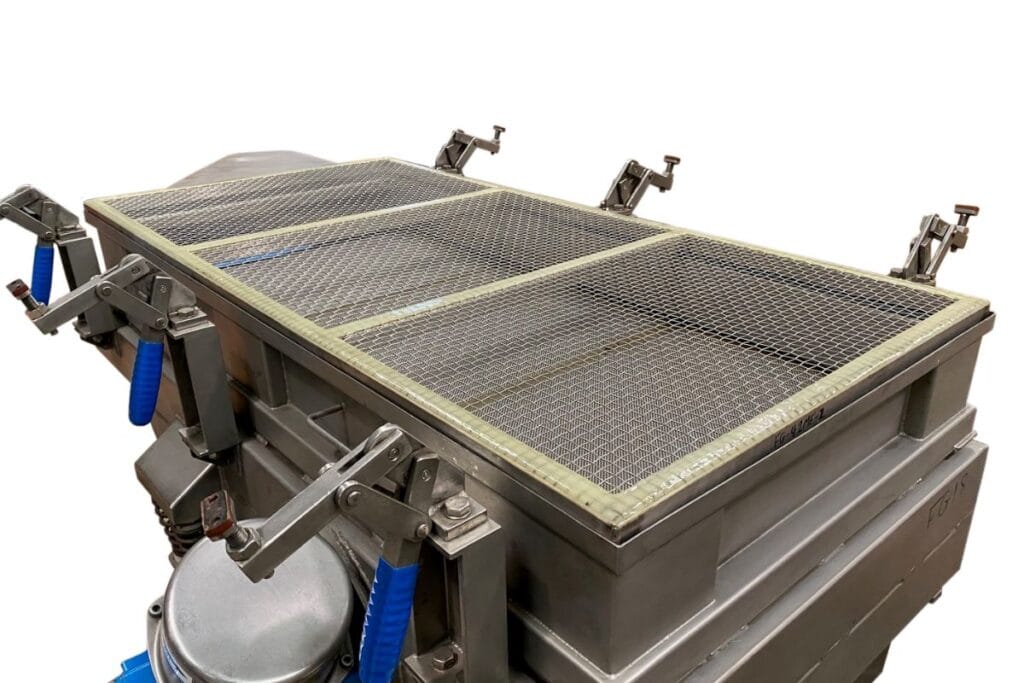Introduction
In food manufacturing, the consistency, safety, and flow of powdered ingredients depend not just on sourcing, but on how they’re handled, screened, and separated during processing. Industrial sieves for food powders and ingredients are essential for removing oversize material, protecting hygiene, and meeting strict food safety and compliance standards.
From de-agglomerating flour to preventing contamination in protein powders, sieving protects both product integrity and downstream equipment. The right food-grade sieving system can minimise waste, improve throughput, and support compliance with regulations such as HACCP, BRCGS, and EC 1935/2004.
This guide explains how to choose the most suitable industrial sieve for your food powders and ingredients – covering powder characteristics, hygiene requirements, mesh types and common equipment configurations. Whether you’re specifying a new system or upgrading an existing one, this article is designed to support informed, technically sound decisions.
Why industrial sieves matter for food powders and ingredients
In the food industry, powders like flour, sugar, starch, protein blends, and seasoning mixes must meet high standards for purity, flow, and consistency. Industrial sieves for food powders and ingredients play a key role in achieving these standards, acting as both a quality control step and a protective barrier against contamination.
Food powders often present unique challenges: they may clump, absorb moisture, carry static, or contain natural variation in particle size. Without proper screening, these issues can result in blocked machinery, inconsistent mixes, or product recalls due to foreign bodies or cross-contamination. Sieving helps prevent these problems by removing oversize material, separating fines, and ensuring uniform flow to downstream equipment.
In many cases, industrial sieving equipment also acts as a Critical Control Point (CCP) under HACCP protocols. This is especially true in allergen-sensitive or high-care environments, where contamination risks are tightly regulated. Sieve selection can also influence traceability, hygiene, and cleanability – key factors for meeting compliance standards such as EC 1935/2004, FDA food contact requirements, and BRCGS certification.
Farleygreene provides sieving systems specifically designed for food industry applications, offering a range of solutions that address the challenges of powder handling, hygiene, and compliance across bakery, dairy, nutraceutical and seasoning sectors.

Common food powders and ingredients that require sieving
In modern food manufacturing, a wide variety of powders and granular ingredients must be screened to ensure consistency, safety, and process efficiency. From fine flours to dense protein blends, industrial sieves for food powders and ingredients help ensure these materials are free from oversize particles, foreign bodies, and inconsistent fractions that could disrupt downstream operations or compromise product quality.
Commonly sieved food powders and ingredients include:
- Flour (wheat, rye, rice, gluten-free, etc.): prone to lumping and needs deagglomeration before mixing or packaging
- Sugar (granulated, icing, demerara): used in coatings, baking, and confectionery; requires tight control of particle size
- Starches (corn, potato, tapioca): often dusty and may block screens if not properly handled
- Cocoa powder: light, fine, and often electrostatically charged, making it prone to clumping
- Milk and dairy powders (whey, casein, milk protein concentrate): highly sensitive to moisture and often require hygienic, sealed systems
- Nutritional and protein powders: such as pea, soy, or whey blends used in supplements and ready-to-drink products
- Spices and seasoning blends: which may contain both fine and coarse components, requiring effective separation
- Dry bakery mixes and premixes: combining multiple powdered ingredients that must be homogenous before further processing
- Fortification agents (e.g. calcium, vitamins, iron): added in small quantities and need accurate dispersion without clumping
Each of these materials presents different flow behaviours, dust risks, and hygiene concerns. Choosing the right food-grade industrial sieve depends on understanding the physical characteristics of the ingredient and the processing stage in which sieving is required.
How to choose the right industrial sieve for food powders and ingredients
Selecting the most suitable industrial sieve for food powders and ingredients requires more than just picking a mesh size. It involves understanding how your powders behave, what the process demands are, and how regulatory and hygiene requirements influence equipment design. Below are key factors to consider when evaluating sieving systems for food processing.
1. Powder characteristics
Different powders behave differently under vibration or centrifugal force. Key considerations include:
- Particle size and distribution: Finer powders may blind screens more easily, while coarse or irregular particles may require stronger vibration or larger mesh apertures.
- Flowability: Ingredients with poor flow characteristics may require mechanical aids or specific orientations to pass through the sieve.
- Moisture content and static charge: Hygroscopic or electrostatically charged powders (like cocoa or milk protein) may require ultrasonic deblinding systems or sealed units.
2. Throughput and batch size
The amount of product you process, and how frequently it changes, will determine the type and scale of sieve you need.
- High-volume processing may call for centrifugal sifters or large vibratory sieves capable of continuous operation.
- Small batch or pilot-scale production may benefit from compact, easy-to-clean units that allow for frequent product changes.
You can test your powders on different sieving systems at Farleygreene’s in-house testing facility to determine the best option before investing.
3. Hygiene and cleanability
Food processing equipment must be easy to clean and designed to minimise the risk of contamination – especially when handling allergen-sensitive or high-care products.
- Choose sieving equipment with crevice-free construction, food-grade stainless steel (304 or 316L), and polished welds for ease of cleaning.
- Look for units compatible with CIP (Clean-in-Place) systems where regular disassembly is not practical.
- For allergen-sensitive operations, ensure quick mesh changeover and access to dedicated spare parts for each product line.
4. Installation point in the process
Where the sieve sits in your process line affects both its function and the type of equipment required.
- Pre-mix sieving removes contaminants before blending.
- Post-mix sieving ensures uniformity before packaging.
- Sieves can also be used inline between stages to screen product as it’s conveyed through the line.
5. Compliance and traceability
Food processing equipment must meet specific material and documentation standards, including:
- FDA food contact compliance (for US markets). For more details, see the FDA Food Contact Substances Guidance
- EC 1935/2004: Ensures that materials in contact with food are safe, inert and fully traceable throughout the supply chain (EU regulation).
- EC 2023/2006 (GMP): Requires that materials intended for food contact are manufactured under Good Manufacturing Practice.
- EN 10204 3.1 certification: Provides traceability and verified test data for stainless steel grades used in contact parts such as mesh rings, housings, and contact plates.
- ATEX compliance: Required when sieves are used in environments with explosive dust, vapours or powders.
- BRCGS/HACCP documentation support: Helps manufacturers demonstrate hygiene, traceability, and cleaning validation in line with food safety audit expectations.
By weighing these considerations, food manufacturers can better specify sieving equipment that delivers consistent performance, supports regulatory compliance, and adds long-term value to their production process.

Types of industrial sieves for food powders and ingredients: comparison and use cases
Industrial sieves are not one-size-fits-all, especially when handling food powders and ingredients. The choice of sieving system depends on factors such as product texture, flowability, hygiene requirements, and throughput rates. Below is a breakdown of the most widely used sieve types, optimised for food industry applications.
1. Check sieves (police sieving)
Check sieving, also known as police sieving, is the most common type of industrial sieving in food production. Its primary function is to ensure safety and product quality before the next stage of processing or packaging.
These sieves are used to:
- Remove foreign bodies: Ensure no unexpected contaminants (e.g. packaging fragments, glove parts, insects) have entered the product stream.
- Break up lumps: Prevent agglomerates of powders, starches, or flavourings from affecting downstream processing.
- Perform quality checks: Act as a critical control point (CCP) for food safety systems like HACCP.
Check sieves are typically installed just before packaging or after mixing, where space is limited but hygiene and throughput are essential.
Farleygreene’s Slimline range is designed for efficient check sieving in hygienic environments, with compact form factors and easy-clean access.
2. Grading sieves
Grading sieving is a more precise operation than check sieving. It separates materials into distinct particle size bands or “cuts”, ensuring uniformity in finished food products or ingredients that must meet tight specifications.
These sieves are designed to:
- Create multiple particle size cuts: Up to four mesh decks with decreasing aperture sizes can separate fine, mid-sized, and oversize particles.
- Use the right configuration for separation efficiency: Traditional multi-deck sieves are compact and ideal for most grading applications, but in high-throughput or complex processes, a series of single-deck sieves positioned in sequence can improve performance by optimising flow and mesh contact at each stage.
- Reduce risk of contamination: Modular units reduce the potential for cross-contamination between cuts.
Grading is ideal for separating flours, starches, spice blends, or functional ingredients where consistent particle sizing affects product performance.
Farleygreene’s Segregator and Multiscreen ranges both offer modular grading capability.
3. Centrifugal or rotary sifters
Centrifugal sifters operate using internal paddles that rotate at high speed inside a cylindrical mesh, pushing product outward using centrifugal force. This makes them especially suited for sticky or compacted food powders.
These sifters are:
- High-throughput systems: Greater processing capacity than vibratory sieves of similar size.
- Effective on cohesive or sticky ingredients: Ideal for sieving whey powder, casein, powdered cheese, or cocoa.
- Not suitable for delicate products: Aggressive paddling may damage fragile food particles or oversize by breaking them up and forcing them through the mesh.
Centrifugal sifters are enclosed systems, helping reduce dust in dry powder environments.
Farleygreene’s Rota range is optimised for sticky or fatty food powders and bulk throughput.
4. Linear sieves
Linear sieving uses a straight, horizontal motion to move product across a rectangular mesh. The long dwell time allows efficient separation, particularly where there’s a high percentage of oversize or fines.
These sieves are suited to:
- Delicate or friable materials: Gentle linear motion avoids damaging brittle products like extruded snacks or sugar crystals.
- High oversize content: The sieve’s length allows fines to pass through without being blocked by larger particles.
- Integrated conveying: Can replace or supplement conveyors and even lift product if installed on an incline.
- De-dusting or alignment tasks: Used for removing loose flour from biscuits or aligning capsules in pharma-style applications.
Farleygreene’s Segregator range offers precision alignment and grading for high-value or delicate food powders and capsules.
5. Ultrasonic sieves
Ultrasonic sieving enhances a vibratory sieve with high-frequency ultrasonic waves applied directly to the mesh. This energy keeps fine or electrostatic powders moving, preventing mesh blinding and improving flow.
These sieves are ideal for:
- Very fine powders: Used where particle sizes are below 100µm, such as milk powders, spice dusts or protein isolates.
- Electrostatic or clumping materials: Suitable for cocoa, starches, gums, and emulsifiers that tend to cake.
- Widely used in additive dosing or pre-weighing systems: Particularly in dry blend plants handling minor ingredients, premixes, or allergens where product purity is critical before mixing.
Ultrasonic systems are an add-on to a standard vibratory sieve, rather than a type of sieve in itself. Farleygreene’s ultrasonic systems are available as upgrades to the Slimline and Multiscreen ranges.

Mesh specifications and selection
Choosing the correct mesh is one of the most critical aspects of specifying an industrial sieve for food powders and ingredients. Mesh type, aperture, and wire thickness all affect how efficiently your product is screened and ultimately how much usable material you recover.
Woven wire mesh is the most used option in vibratory sieving. It’s made by interlacing metal (typically stainless steel), nylon, or other materials to form a grid of apertures. These meshes are available in a wide range of aperture sizes and wire diameters, allowing precise control over particle separation. However, they must be handled with care. Woven wire is susceptible to warping or breakage over time, particularly in high-throughput or abrasive applications, so regular inspection and replacement is essential.
Perforated plate mesh is a durable alternative made from solid sheet metal with precision-punched holes. While it offers limited sizing flexibility and lower open area (which can reduce throughput), it is far more resistant to damage, making it suitable for robust sieving. Aperture sizes for perforated plate tend to be standardised to whole or half millimetres.
Wedge wire mesh, often used in centrifugal sifters and some linear screeners, is made from parallel wedge-shaped wires welded to support rods. This design creates long narrow slots that are much harder to blind (block), providing very consistent throughput over time. Wedge wire is typically more expensive to manufacture but offers exceptional durability and reliability for continuous or difficult-to-screen materials.
When specifying mesh, consider the following:
- Aperture size: The distance between wires (measured in mm or microns) determines the maximum particle size that can pass through. Accurate particle size data is essential when choosing the right aperture for your product.
- Mesh count: Expressed as the number of openings per linear inch (e.g. 80 mesh), this is closely linked to aperture size but not interchangeable – two meshes can have the same count but different wire diameters, and therefore different open areas.
- Wire diameter: Thicker wires increase mesh strength and durability but reduce open area. Thinner wires improve throughput and sensitivity, especially for fine powders, but may be more prone to damage.
- Open area: Expressed as a percentage, this is the proportion of the mesh that is made up of holes rather than wires. A higher open area allows greater throughput but may reduce mesh longevity or structural integrity.
- Pre-tensioned mesh systems: These hold mesh screens under consistent tension inside frames, maintaining flatness and performance. They are quick to change and reduce the risk of blinding.
Your mesh selection will vary depending on your ingredient type (e.g. flour, starch, milk powders, sugar), desired throughput, regulatory constraints, and cleaning requirements. In allergen-sensitive environments or where frequent product changeovers are required, mesh frames with tool-free removal can drastically reduce downtime and risk.
In Summary: Selecting the right sieve for food powders and ingredients
Choosing the right industrial sieve for food powders and ingredients is about understanding how powders behave, where the sieve fits in your process, and how hygiene, allergen control, and certification requirements influence equipment design. The wrong choice can lead to reduced capacity on production lines, contamination risks, and costly downtime, while the right system will support product quality, compliance, and long-term efficiency.
Whether you’re handling fine flour, sticky whey powder, lumpy spice blends or high-value nutraceuticals, Farleygreene can help you specify a sieving solution that’s built around your product, your line layout, and your operational needs.
Need help choosing the right sieve for your ingredients?
Contact Farleygreene to speak to a food industry specialist or book a product trial using your own powders.
…………………………………………………………………………………………………………………………………………………………………………………………………………………………………………………………………..
FAQs: Industrial sieves for food powders and ingredients
1. What type of sieve is best for sieving flour, sugar or starches?
For dry, free-flowing powders like flour and sugar, vibratory check sieves such as Farleygreene’s Slimline range are commonly used. These ensure product purity and consistency while maintaining hygiene.
2. Can a sieve help reduce the risk of allergen contamination?
Yes. Sieves play a key role in allergen control by improving product separation and preventing cross-contact when used alongside proper cleaning and segregation procedures. Opt for models with quick-release clamps and tool-free mesh change systems to enable fast clean-down between batches
3. How do I select the right mesh size for food powders?
Mesh size depends on the particle size of your product and the level of separation required. Testing is recommended to balance throughput and separation efficiency. Contact Farleygreene for in-house trials using your product.
4. Are ultrasonic sieves suitable for food powders?
Yes, particularly for fine or hygroscopic powders that are prone to blinding the mesh. Ultrasonic deblinding systems help maintain consistent flow and reduce downtime.
5. How can sieving improve product texture and quality?
Sieving removes lumps, foreign objects and inconsistent particles, ensuring smooth product texture, essential for mixes, coatings and baking applications.
6. Is a centrifugal sieve better for sticky or fatty food ingredients?
Yes. Centrifugal sifters are ideal for fatty or oily (sticky) powders or compressed powders, where vibration alone may not be enough. However, they’re less suited for fragile products that need gentle handling.
7. What hygiene standards should food sieves meet?
Industrial sieves for food processing must comply with CE, UKCA, FDA, and EC 1935/2004. Look for hygienic design features such as crevice-free welds, stainless steel contact parts, and CIP compatibility.
8. Can I validate a sieve’s performance with my actual food powder?
Yes, Farleygreene offers product trials at their in-house testing facility. This allows you to test mesh sizes, flow rates and system configurations using your actual product.


